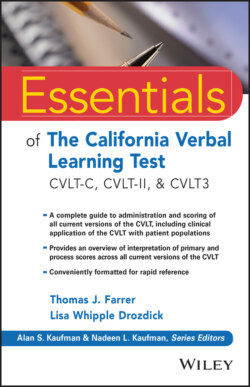Читать книгу Essentials of the California Verbal Learning Test - Thomas J. Farrer - Страница 17
Processes of Memory
ОглавлениеEdith Kaplan and colleagues introduced the process approach to cognitive assessment (Kaplan, 1988; Libon, Swenson, Ashendorf, Bauer, & Bowers, 2013) through their work at the Boston Veterans Administration Medical Center. This approach places importance on assessing not just what an individual is able to do but also how they do it. The approach utilizes overall test scores to assess the severity of impairment but emphasizes the analysis of the process through which test scores are achieved and errors made. Similar overall test scores can be obtained through very different processes. The development of the CVLT applied this process approach to learning and memory. Through studies involving individuals with brain injuries or disorders, strengths and weaknesses of memory processes were identified that differed across and within clinical populations. The instrument was refined to capture these processes and allow further investigation. So, although importance is placed on the primary measures of recall accuracy; critical attention is also given to the processes underlying performance.
Performance on memory specific measures is not only influenced by learning and memory processes but also by other cognitive functions. For example, attentional processes and learning strategies have an impact on the encoding and retrieval of verbal information. The interrelated nature of processes utilized across cognitive abilities requires that the assessment of memory include the assessment of these related processes. The CVLT versions measure the specific processes of learning and memory and processes related to the success and failure of encoding and retrieval of information. This allows examiners to examine differences in performance due to specific cognitive deficits. Figure 1.3 displays the processes measured directly within the CVLT editions.
The ability to encode information is highly dependent upon the ability to perceive and attend to information. Auditory attention is a key precursor for adequate memory retention. Individuals who have difficulty focusing on information long enough to encode it will not be able to retain that information over time. The first trial of the CVLT provides information on auditory attention span. It correlates highly with other measures of attention and is impaired in clinical groups with known attentional deficits, such as those with anxiety or mood disorders. Most individuals improve in overall recall across the learning trials, so comparison of performance across trials can assist in teasing out the influence of attention on memory problems.
Learning is the acquisition of new information. Historically it has been measured through overall recall across learning trials or by assessing the learning slope, the amount of information gained after the initial learning trial. These measures are included in the CVLT editions but the CVLT editions go further to evaluate learning strategies and characteristics and consistency of recall. Learning involves both passive and active strategies. Rote repetition is a passive strategy for recalling information that increases consolidation but does not involve increasing efficiency of encoding information. Repetition requires that information is repeated multiple times for encoding to occur. This type of learning strategy is represented in serial clustering or recalling words together that were close serially in the original list. Alternatively, active strategies of organizing information into meaningful groups aid the encoding and retrieval of information. The semantic grouping of words by an examinee represents utilization of this active learning strategy. Information on strategies used to encode information can aid in developing interventions for improving active learning.
Figure 1.3 Memory processes measured in the CVLT.
In addition to evaluating learning strategies, data on the recall of words from different sections of the word list are provided. It is typical for individuals to recall more information from the beginning of a list (primacy effect) and from the end of a list (recency effect) than from the middle of a list. The primacy effect is generally attributed to greater rehearsal time for information whereas the recency effect is potentially related to the last words being held in recent or working memory. Examinees with encoding deficits often show higher recency effects than observed in the normative sample. Finally, consistency of recall provides information on the consistent application of recall strategies to retrieval of information. Individuals with executive functioning difficulties (e.g., poor planning, poor organization) often produce inconsistent profiles of responding. While this affects overall recall, executive functioning may be a key deficit in these cases.
The introduction of a second word list introduces active interference into the assessment of memory. Other measures utilize unrelated tasks to fill in between immediate and delayed recall but the CVLT actively introduces a second, similar list to explicitly assess interference. Two of the four semantic categories overlap across the two lists further eliciting interference effects. Comparison of performance on Trial 1 and the interference trial provides a measure of proactive interference, the decline in performance on learning material due to prior learning.
Whereas the level of recall on the immediate and delayed recall trials reflects overall retrieval, errors in recall provide insight into specific memory dysfunction and are invaluable in differential diagnoses. Repetitions or repeated responses are common in individuals with normal memory functioning when the repetition is used as self-cueing to promote further recall. However, repetitions can also be a sign of perseverative responding, the failure to inhibit previous responses, or poor self-monitoring. Intrusions, responses not from the current word list, are relatively uncommon in individuals without memory difficulties. Examination of the specific types of intrusions, which trials they occur on, their semantic relationships to the items in the word lists, and whether they are repeated across or within trials is critical to differentiating clinical groups. All clinical groups demonstrate deficits in memory recall; however, intrusions provide specific information about performance that aids in differentiating clinical groups.
